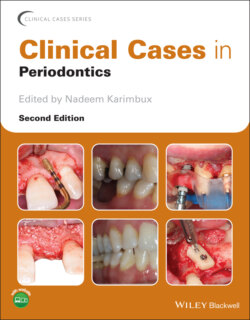Читать книгу Clinical Cases in Periodontics - Группа авторов - Страница 73
References
Оглавление1 1. Murakami S, Mealey BL, Mariotti A, Chapple ILC. Dental plaque‐induced gingival conditions. J Periodontol 2018; 89(Suppl 1):S17–S27.
2 2. Capodiferro S, Tempesta A, Limongelli L, et al. Nonsurgical periodontal treatment by erbium:YAG laser promotes regression of gingival overgrowth in patient taking cyclosporine A: a case report. Photobiomodul Photomed Laser Surg 2019; 37:53–56.
3 3. Caton JG Jr, Rees T, Pack A, et al. Consensus report: Non‐plaque‐induced gingival lesions. Ann Periodontol 1999; 4:30–31.
4 4. Hart TC, Pallos D, Bozzo L, et al. Evidence of genetic heterogeneity for hereditary gingival fibromatosis. J Dent Res 2000; 79:1758–1764.
5 5. Hart TC, Zhang Y, Gorry MC, et al. A mutation in the SOS1 gene causes hereditary gingival fibromatosis type 1. Am J Hum Genet 2002; 70:943–954.
6 6. Lynch MA, Ship II. Initial oral manifestations of leukemia. J Am Dent Assoc 1967; 75:932–940.
7 7. Dreizen S, McCredie KB, Keating MJ. Chemotherapy‐associated oral hemorrhages in adults with acute leukemia. Oral Surg Oral Med Oral Pathol 1984; 57:494–498.
8 8. Mariotti A. Dental plaque‐induced gingival diseases. Ann Periodontol 1999; 4:7–19.
9 9. Listgarten MA. Periodontal probing: what does it mean? [review]. J Clin Periodontol 1980; 7:165–176.
10 10. Trackman PC, Kantarci A. Connective tissue metabolism and gingival overgrowth. Crit Rev Oral Biol Med 2004; 15;165–175.
11 11. Black SA Jr, Palamakumbura AH, Stan M, Trackman PC. Tissue‐specific mechanisms for CCN2/CTGF persistence in fibrotic gingiva: interactions between cAMP and MAPK signaling pathways, and prostaglandin E2‐EP3 receptor mediated activation of the c‐JUN N‐terminal kinase. J Biol Chem 2007; 282:15416–15429.
12 12. Kantarci A, Black SA, Xydas CE, et al. Epithelial and connective tissue cell CTGF/CCN2 expression in gingival fibrosis. J Pathol 2006; 210:59–66.
13 13. Uzel MI, Kantarci A, Hong HH, et al. Connective tissue growth factor in drug‐induced gingival overgrowth. J Periodontol 2001; 72:921–931.
14 14. Kantarci A, Augustin P, Firatli E, et al. Apoptosis in gingival overgrowth tissues. J Dent Res 2007; 86:888–892.
15 15. Volchansky A, Cleaton‐Jones P. Delayed passive eruption: a predisposing factor to Vincent’s infection. J Dent Assoc S Africa 1974; 29:291–294.
16 16. Volchansky A, Cleaton‐Jones P. The position of the gingival margin as expressed by clinical crown height in children ages 6–16 years. J Dent 1975; 4:116–122.
17 17. Goldman HM, Cohen DW. Periodontal Therapy, 4th edn. St. Louis, MO: Mosby, 1968.
18 18. Marshall RI, Bartold PM. A clinical review of drug‐induced gingival overgrowths. Aust Dent J 1999; 44:219–232.
19 19. Hall EE. Prevention and treatment considerations in patients with drug‐induced gingival enlargement. Curr Opin Periodontol 1997; 4:59–63.
20 20. Ilgenli T, Atilla G, Baylas H. Effectiveness of periodontal therapy in patients with drug‐induced gingival overgrowth. Long‐term results. J Periodontol 1999; 70:967–972.
21 21. Ciancio SG, Bartz NW Jr, Lauciello FR. Cyclosporine‐induced gingival hyperplasia and chlorhexidine: a case report. Int J Periodontics Restorative Dent 1991; 11:241–245.
22 22. Prasad VN, Chawla HS, Goyal A, et al. Folic acid and phenytoin induced gingival overgrowth: is there a preventive effect? J Indian Soc Pedod Prev Dent 2004; 22:82–91.
23 23. Chand DH, Quattrocchi J, Poe SA, et al. Trial of metronidazole vs. azithromycin for treatment of cyclosporine‐induced gingival overgrowth. Pediatr Transplant 2004; 8:60–64.
